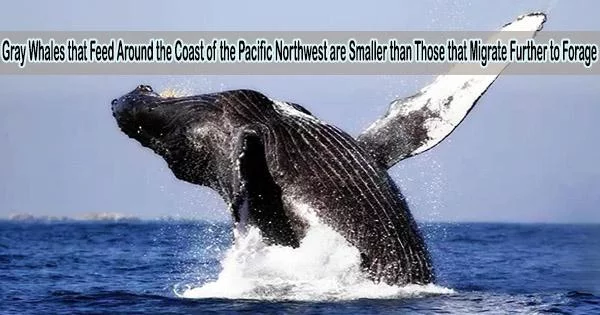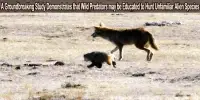According to recent research from the Marine Mammal Institute at Oregon State University, gray whales who spend their summers grazing off the coast of Oregon are smaller than their counterparts that migrate to the Arctic to find food.
The smaller Pacific Coast Feeding Group of gray whales, which is a subdivision of the larger Eastern North Pacific whales, has both male and female gray whales. The females average 3 feet (about 1 meter) shorter, and males average 1.5 feet (half a meter) shorter, said the study’s lead author, K.C. Bierlich, a postdoctoral scholar in the institute’s Geospatial Ecology of Marine Megafauna Laboratory.
“That is a significant difference in size. We also found that the Pacific Coast Feeding Group whales had slightly smaller skulls and flukes,” he said. “It’s a surprising finding we have not thought about these whales being different in this way before.”
The findings, published today in the journal Biology Letters, raise new questions about the health, behavior and management of the Pacific Coast Feeding Group, said study co-author Leigh Torres, an associate professor at Oregon State who leads the GEMM Lab.
The majority of the approximately 16,000 gray whales in the Eastern North Pacific population pass by the coast of Oregon on their annual migrations, which take place between October and December as they head south to Mexico for their winter breeding grounds and again in March as they head north to their summer feeding grounds in the Bering and Chukchi seas between Alaska and Russia.
In contrast, the 212 whales who make up the Pacific Coast Feeding Group spend the summer months feeding in the coastal waters of Oregon, northern California, Washington, and southern Canada.
Since 2015, Torres and her research team have been studying the health and habits of the Pacific Coast Feeding Group, also known as Oregon’s “summer resident” gray whales, because of their unique ecology and elevated exposure to human activities in some locations, including boat traffic, noise and pollution.
When we look at the growth curves for the two populations, we see that they grow at the same rate, but reach different final lengths. That raises some interesting questions: Is this size difference normal for this group of whales and they are a healthy population, but just differently shaped? Or is this difference a sign that they are stressed, unhealthy or not getting enough to eat?
K.C. Bierlich
Photographs are used to identify individuals, nets are used to collect fecal samples, and drones are used to take aerial pictures to measure the body size of individual whales. These techniques offer scientists a wealth of non-invasive information about the ecology and health of the whales.
“What is really unique about our data on the Pacific Coast Feeding Group is that we know these whales really well,” Bierlich said. “We see the same whales every year and can identify individuals based on unique markings, use sighting history from photo identification to estimate their age, collect fecal samples to determine their sex, and use drone imagery to measure their length, skull and fluke size.”
“A big question our research group has been debating for a while is why these whales come here instead of going farther north like the larger group,” he said.
Bierlich recognized an opportunity to contrast the Pacific Coast Feeding Group with the Eastern North Pacific whales because one of his research interests is employing non-invasive methods, such as drones, to examine whale health and behavior. He started to notice variations between the two groups using a combination of historical whaling records, information from stranded animals, observations from airplanes, and information gathered using contemporary non-invasive approaches, including drones.
“When we look at the growth curves for the two populations, we see that they grow at the same rate, but reach different final lengths,” he said. “That raises some interesting questions: Is this size difference normal for this group of whales and they are a healthy population, but just differently shaped? Or is this difference a sign that they are stressed, unhealthy or not getting enough to eat?”
When resources are scarce, animals frequently shrink in size and length, but Bierlich pointed out that the variation can possibly be the result of a regional adaptation.
“These whales live in a very shallow environment, feeding in the kelp forest near shore, so the differences could be a reflection of their environment,” he said. “Their smaller body size and shorter skulls and flukes could potentially help them feed more effectively in this habitat compared to the deeper waters where the Eastern North Pacific whales feed.”
The findings may also have implications for future population management.
“Being smaller means these gray whales may have less energetic storage available to support reproduction or response to disturbance and injuries,” Torres said. “More research is needed to understand what may be driving the size differences between the two populations.”
In the United States, the Pacific Coast Feeding Group is managed as part of the larger Eastern North Pacific Group. The differences in size could raise questions about whether the Pacific Coast whales should be managed separately.
“With only 212 Pacific Coast Feeding Group whales, these whales might require different management strategies compared to the 16,000 whales in the Eastern North Pacific,” Bierlich said.
Additional co-authors include Oregon State’s Ally Kane, Lisa Hildebrand, Clara Bird, Alejandro Fernández Ajó, Josh Stewart, Ines Hildebrand and James Sumich and Duke University’s Joshua Hewitt. The Marine Mammal Institute is part of Oregon State’s College of Agricultural Sciences and is based at Hatfield Marine Science Center in Newport.
















